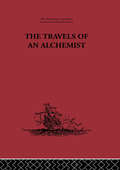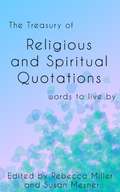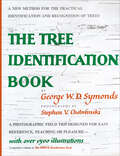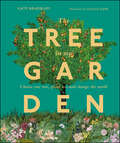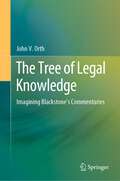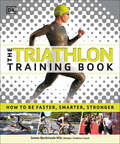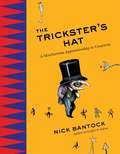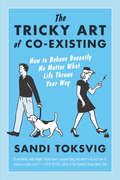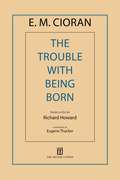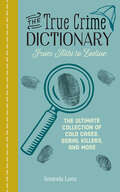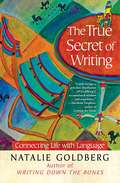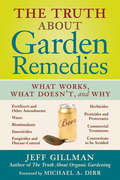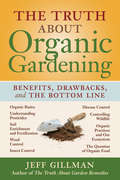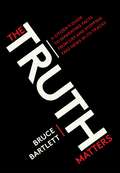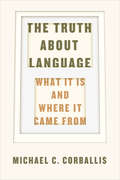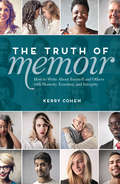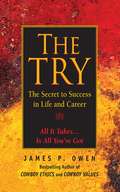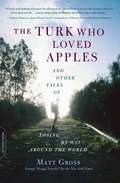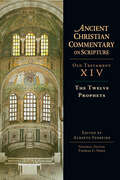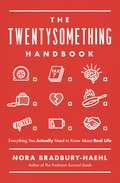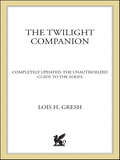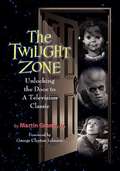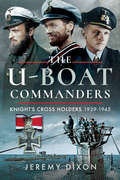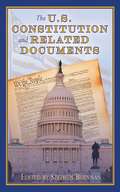- Table View
- List View
The Travels of an Alchemist: The Journey of the Taoist Ch'ang-Ch'un from China to the Hundukush at the Summons of Chingiz Khan
by Li Chih-Ch'angFirst published in 1931. Mainly focussing on cultural and geographical aspects, Travels of an Alchemist are unique in their importance as a source for early Mongol history, enabling us as they do to fix with certainty the otherwise obscure and much disputed dates of Chingiz Khan's movements during his Western campaign. The author, a Taoist doctor, left some of the most faithful and vivid pictures ever drawn of nature and society between the Aral and the Yellow Sea. Waley's introduction provides excellent background information with which to place the Travels in their appropriate historical, social and religious setting.
The Treasury of Religious and Spiritual Quotations
by Rebecca Miller Susan MesnerThe Treasury of Religious and Spiritual Quotations organizes its contents by category: angels and agnosticism, suicide and capital punishment, nature and technology, clergy and repentance. Quotes from wide-ranging religious and spiritual sources, including the Bhagavad Gita, the Talmud, and the Bible, give readers a holistic understanding of some of life's most monumental issues. Based on Ralph L. Woods' seminal reference book of religious sayings, this book is sure to spark reflection and inspire readers of all faiths to ye of little faith--or none at all.
The Tree Identification Book
by George W. SymondsThe classic easy-reference field guide with more than 1500 photographs: &“An almost foolproof practical reference book.&” —Kirkus Reviews (starred review) This useful book for botanists, horticulturists, and nature lovers is made up of two parts: Pictorial Keys and Master Pages. The Keys are designed for easy visual comparison of details that look alike, narrowing the identification of a tree to one of a small group—the family or genus. Then, in the Master Pages, the species of the tree is determined, with similar details placed together to highlight differences within the family group, thus eliminating all other possibilities. All of the more than 1500 photographs were made specifically for use in this book and were taken either in the field or of carefully collected specimens. Where possible, details such as leaves, fruit, etc., appear in actual size, or in the same scale.
The Tree in My Garden: Discover the Difference One Tree Can Make - Then Plant Your Own
by DKOne tree, in one garden. Can it really make a difference?In RHS The Tree in My Garden, award-winning wildlife author Kate Bradbury reveals the amazing effect planting a single tree in your garden can have - and dares to imagine what would happen if every gardener up and down the country did the same. Combining practical gardening advice, eye-opening scientific research, reflections on the cultural importance of different species, and evocative accounts of how vital trees are for countless different forms of wildlife, this book will leave you in no doubt that every garden needs a tree!This terrific tree book features a directory of 50 key species, each one beautifully illustrated by Lucille Clerc and packed with information about each tree's appearance, care needs, carbon sequestration ability, and the wildlife it supports - to help you choose the best tree for your own garden, or learn more about the trees you may already have. Dive into the pages of this tree identification book to discover: - 50 illustrated profiles of a wide range of trees suitable for different gardens and preferences- Interesting anecdotes about history and folklore associated with the tree.- Eye-opening accounts of the importance of trees for our planet, our wildlife, and ourselves- Essential practical information to help readers choose, plant, prune, and care for their tree- Ideas for making your own leafmould and ways to get involved in community planting projects.- Stunning illustrations by Lucille Clerc that convey the beauty and the mystery of treesThis book is perfect for anyone wanting to attract more wildlife to their garden! So whether you&’re an environmentalist intent on reducing your carbon footprint, a budding gardener looking to choose the best tree for your outdoor space or you&’re simply seeking a guide about the natural history of the trees in your garden, RHS The Tree In My Garden is something the whole family can explore, discover and love. No garden should be without a tree. Plant one, watch it grow - and become part of something bigger!
The Tree of Legal Knowledge: Imagining Blackstone’s Commentaries
by John V. OrthThis book restores to view a masterpiece of beauty and legal scholarship, which has been lost for almost two hundred years. Produced anonymously in 1838, The Tree of Legal Knowledge is an elaborate visualization in five large colored plates of the law as stated in Sir William Blackstone’s Commentaries on the Laws of England. Intended as “an assistant for students in the study of law,” the study aid was not a simple diagram but a beautiful tree with each branch and twig labeled with legal terms and concepts from the Commentaries. Not for law students only, the original was also intended to be of use to the practicing attorney and educated gentleman “in consolidating his learning and forming an instructive and ornamental appendage to an office.” Although Blackstone’s Commentaries had been first published eighty years earlier, it remained the primary source for knowledge of English law and required reading for American law students. The Commentaries remain relevant today and are frequently cited by the U.S. Supreme Court as a source for the original understanding of legal rights and obligations at the time of American Independence. Despite its artistic beauty and academic significance, The Tree of Legal Knowledge had seemingly disappeared shortly after its publication. It is not included in the collection of any library, including the Library of Congress or in Yale University’s Blackstone Collection, the largest in the world. It is not listed in the comprehensive Bibliographical Catalog of William Blackstone, edited by Ann Jordan Laeuchli, published for the Yale Law Library in 2015. The present volume reproduces the only extant copy of The Tree of Legal Knowledge. It includes an introduction by the editor that places The Tree in historical context and identifies the anonymous author, an otherwise unknown lawyer. In addition, it reprints the original author’s introduction and “explanation of the branches,” both extensively annotated. This book restores this lost masterpiece to its proper place in legal history. The Tree is a beautiful—and accurate—depiction of English law as expounded in Blackstone’s Commentaries, the single most important book in the history of the common law.
The Triathlon Training Book: How to Be Faster, Smarter, Stronger
by DKThe Triathlon Training Book is your one-stop reference for training and competing in a triathlon. Find all the essentials you need to start training and improve your performance: • Clear, customizable training plans for all triathlon distances. • Step-by-step exercises to build your strength. • Incredible illustrations that explain efficiency and speed. • Expert advice on race-day strategy, nutrition, and equipment. • Trustworthy advice on treating common triathlon injuries and maintaining a healthy body. Whether you are a first-timer or a seasoned Ironman veteran, you'll find what you need in The Triathlon Training Book. There's even a special performance chapter with detailed anatomical artwork that explains the physiology and body mechanics for swimming, cycling, and running so you can see what's happening inside your body as you train.
The Trickster's Hat
by Nick BantockThe act of creating art, in all its forms, offers us a path to our souls. But the path can be confusing, and getting lost along the way is inevitable. However, maybe that's the point. In The Trickster's Hat, bestselling author of the Griffin & Sabine cycle Nick Bantock invites you to lose yourself in order to become a better creator. Inspired by Nick's popular and mischievous workshops, the book's forty-nine perceptive exercises will encourage you to forget your destination while you meander through the wondrous world that awaits you in the periphery of your mind's eye. If you're willing to be lead hither and thither down unlikely paths by a fellow of dubious reputation, if you're prepared to keep a sense of humor and not be phased when he plucks the unexpected out of a mischief-stuffed hat, if you're ready to zigzag, detour, and wander in search of a better understanding of your artistic core, then, let the Trickster be your guide.
The Tricky Art of Co-Existing: How to Behave Decently No Matter What Life Throws Your Way
by Sandi Toksvig“If you do it right, being a grown-up is just like being a kid . . . but without people telling you off.” No one learns “etiquette” anymore (except by embarrassing trial and error). But manners are more than a dusty tradition: Done right, they make life easier—for everyone! That’s why Sandi Toksvig highlights decency rather than convention in this entertaining guide, with:Spot-On Advice: “Remember—you don’t have to answer the phone, so don’t do it if you don’t have time to be polite.”Fascinating Trivia: “It is very rude to clear the plate of someone who hasn’t finished. In fact, the Romans believed doing so would bring about the diner’s sudden death.”And Her Characteristic Wit: “Focusing on the people you share a meal with is both a pleasure and a necessity. Get to know your family members; you might even like them.”Be the most decently behaved person in the room, and the most interesting: Master The Tricky Art of Co-Existing!
The Trouble with Being Born (Quartet Encounters Ser.)
by E. CioranIn this volume, which reaffirms the uncompromising brilliance of his mind, Cioran strips the human condition down to its most basic components, birth and death, suggesting that disaster lies not in the prospect of death but in the fact of birth, "that laughable accident." In the lucid, aphoristic style that characterizes his work, Cioran writes of time and death, God and religion, suicide and suffering, and the temptation to silence. Through sharp observation and patient contemplation, Cioran cuts to the heart of the human experience.
The True Crime Dictionary: The Ultimate Collection of Cold Cases, Serial Killers, and More
by Amanda LeesAn extraordinary A-to-Z reference of killers, poisons, police jargon, prison slang, forensics terms, and much more. Immerse yourself in the fascinating world of criminology with the one and only True Crime Dictionary. Containing everything from famous crimes, cold cases, and serial killers to deadly weapons, spy lingo, and legal language, this book is sure to enthrall true crime lovers. Get an in-depth look at familiar terms and learn new ones, with entries including: Air America, the dummy corporation for the CIA used for secret military operations Grandma&’s House, prison slang for gang headquarters Amphetamine, the second most popular illegal drug in the world Novichok, the lethal nerve agent developed by Soviet Russia The Golden State Killer (and the DNA evidence that finally caught him), and more It&’s compelling reading for murderinos, true crime junkies, and connoisseurs of macabre trivia, as well as a useful reference for writers, podcasters, or anyone whose work revolves around crime.
The True Secret of Writing
by Natalie GoldbergSit. Walk. Write. These are the barest bones of Natalie Goldberg's revolutionary writing and life practice, which she presents here in book form for the first time. A whole new slant on writing that she developed since the publication of her classic Writing Down the Bones, True Secret workshops have been limited until now to small, intensive groups at a remote center in the rural Southwest. In The True Secret of Writing, Goldberg makes this popular seminar available to any reader. The True Secret is for everyone, like eating and sleeping. It allows you to discover something real about your life, to mine the rich awareness in your mind, and to ground and empower yourself. Goldberg guides you through your own personal or group retreat, illuminating the steps of sitting in silent open mind, walking anchored to the earth, and writing without criticism. Just as Goldberg cuts through her students' resistance with her no-nonsense instruction--"Shut up and write"--the True Secret cuts to the core of realizing yourself and your world. The capstone to forty years of teaching, The True Secret of Writing is Goldberg's Zen boot camp, her legacy teaching. Stories of Natalie's own search for truth and clarity and her students' breakthroughs and insights give moving testament to how brilliantly her unique, tough-love method works. Beautiful homages to the work of other great teachers and observers of mind, life, and love provide further secrets and inspiration to which readers will return again and again. In her inimitable way, Goldberg will inspire you to pick up the pen, get writing, and keep going. The True Secret of Writing will help you with your writing--and your life.
The True Secret of Writing: Connecting Life with Language
by Natalie GoldbergSit. Walk. Write. These are the barest bones of Natalie Goldberg's revolutionary writing and life practice, which she presents here in book form for the first time. A whole new slant on writing that she developed since the publication of her classic Writing Down the Bones, True Secret workshops have been limited until now to small, intensive groups at a remote center in the rural Southwest. In The True Secret of Writing, Goldberg makes this popular seminar available to any reader. The True Secret is for everyone, like eating and sleeping. It allows you to discover something real about your life, to mine the rich awareness in your mind, and to ground and empower yourself. Goldberg guides you through your own personal or group retreat, illuminating the steps of sitting in silent open mind, walking anchored to the earth, and writing without criticism. Just as Goldberg cuts through her students' resistance with her no-nonsense instruction--"Shut up and write"--the True Secret cuts to the core of realizing yourself and your world. The capstone to forty years of teaching, The True Secret of Writing is Goldberg's Zen boot camp, her legacy teaching. Stories of Natalie's own search for truth and clarity and her students' breakthroughs and insights give moving testament to how brilliantly her unique, tough-love method works. Beautiful homages to the work of other great teachers and observers of mind, life, and love provide further secrets and inspiration to which readers will return again and again. In her inimitable way, Goldberg will inspire you to pick up the pen, get writing, and keep going. The True Secret of Writing will help you with your writing--and your life.
The Truth About Garden Remedies: What Works, What Doesn't & Why
by Jeff GillmanCan beer make plants grow? How about buttermilk? Or music—classical or rock? Are you sure about planting trees in deep holes? And how about chasing insects with hot sauce and stopping slugs with eggshells? Whether in ancient books, on television, or in gardening publications, remedies for all your garden woes are here for the taking: the challenge is to know what will work and what won't. Fearlessly conducting original experiments and harvesting wisdom from the scientific literature, horticulturalist Jeff Gillman assesses new and historic advice and reveals the how and why‚ and sometimes the why not‚ for more than 100 common and uncommon gardening practices. The results will surprise even experienced gardeners.
The Truth About Organic Gardening: Benefits, Drawnbacks, and the Bottom Line
by Jeff GillmanGardeners tend to assume that any organic product is automatically safe for humans and beneficial to the environment—and in most cases this is true. The problem, as Jeff Gillman points out in this fascinating, well-researched book, is that it is not always true, and the exceptions to the rule can pose a significant threat to human health. To cite just one example, animal manures in compost can be a source of harmful E. coli contamination if imporperly treated. Gillman's contention is that all gardening products and practices—organic and synthetic—need to be examined on a case-by-case basis to determine both whether they are safe and whether they accomplish the task for which they are intended.Ultimately, Gillman concludes, organic methods are preferable in most situations that gardeners are likely to encounter. After reading this eye-opening book, you will understand why, and why knowledge is the gardener's most important tool.
The Truth Matters: A Citizen's Guide to Separating Facts from Lies and Stopping Fake News in Its Tracks
by Bruce BartlettDistinguish fake news from reliable journalism with this clear and concise handbook by New York Times best-selling author Bruce Bartlett.Today’s media and political landscapes are littered with untrustworthy sources and the dangerous concept of “fake news.” This accessible guide helps you fight this deeply troubling trend and ensure that truth is not a permanent casualty. Written by Capitol Hill veteran and author Bruce Bartlett, The Truth Matters presents actionable tips and tricks for reading critically, judging sources, using fact-checking sites, avoiding confirmation bias, identifying trustworthy experts, and more.
The Truth about Language: What It Is and Where It Came From
by Michael C. CorballisEvolutionary science has long viewed language as, basically, a fortunate accident—a crossing of wires that happened to be extraordinarily useful, setting humans apart from other animals and onto a trajectory that would see their brains (and the products of those brains) become increasingly complex. But as Michael C. Corballis shows in The Truth about Language, it’s time to reconsider those assumptions. Language, he argues, is not the product of some “big bang” 60,000 years ago, but rather the result of a typically slow process of evolution with roots in elements of grammatical language found much farther back in our evolutionary history. Language, Corballis explains, evolved as a way to share thoughts—and, crucially for human development, to connect our own “mental time travel,” our imagining of events and people that are not right in front of us, to that of other people. We share that ability with other animals, but it was the development of language that made it powerful: it led to our ability to imagine other perspectives, to imagine ourselves in the minds of others, a development that, by easing social interaction, proved to be an extraordinary evolutionary advantage. Even as his thesis challenges such giants as Chomsky and Stephen Jay Gould, Corballis writes accessibly and wittily, filling his account with unforgettable anecdotes and fascinating historical examples. The result is a book that’s perfect both for deep engagement and as brilliant fodder for that lightest of all forms of language, cocktail party chatter.
The Truth of Memoir: How to Write about Yourself and Others with Honesty, Emotion, and Integrity
by Kerry CohenBaring the Truth in Your Memoir When you write a memoir or personal essay, you dare to reveal the truths of your experience: about yourself, and about others in your life. How do you expose long-guarded secrets and discuss bad behavior? How do you gracefully portray your family members, friends, spouses, exes, and children without damaging your relationships? How do you balance your respect for others with your desire to tell the truth? In The Truth of Memoir, best-selling memoirist Kerry Cohen provides insight and guidelines for depicting the characters who appear in your work with honesty and compassion. You'll learn how to choose which details to include and which secrets to tell, how to render the people in your life artfully and fully on the page, and what reactions you can expect from those you include in your work--as well as from readers and the media. Featuring over twenty candid essays from memoirists sharing their experiences and advice, as well as exercises for writing about others in your memoirs and essays, The Truth of Memoir will give you the courage and confidence to write your story--and all of its requisite characters--with truth and grace. "Kerry Cohen's The Truth of Memoir is a smart, soulful, psychologically astute guide to first-person writing. She reveals everything you want to know--but were afraid to ask--about telling your life story." --Susan Shapiro, author of eight books including Only As Good as Your Word, and co-author of The Bosnia List
The Try: The Secret to Success in Life and Career
by James P. Owen Randy Glass Brigitte LeBlancWhat is it that separates the doers, leaders, and success stories among us from the dreamers, also-rans, and wannabes? To bestselling author James P. Owen, it’s all about having The Try—the quality of giving 110 percent to the task or challenge at hand.In The Try—a dozen true stories of ordinary people who’ve done extraordinary things across varied fields of endeavor—Owen reveals The Try as a character trait that can be forged in several ways. Some of those profiled are driven by a childhood dream or long held ambition. Others are fueled by someone else’s belief in them, an unwavering belief in themselves, or the urge to pit themselves against daunting odds. Still others find The Try in a life-changing moment when they hit rock bottom or come face-to-face with failure.What all high achievers have in common, Owen believes, is a blend of inner drive, focus, and determination that pushes them to pursue their goals relentlessly, confronting every obstacle, and never, ever giving up. His insightful profiles bring to life new scientific evidence that effort trumps ability. Owen provides inspiration that will strike a chord with anyone who has a lofty goal, a deep personal ambition, or a major challenge to face. By connecting the dots in this collection of stories, he also delivers practical “how to” advice for those who want to cultivate The Try in themselves or those they love.
The Turk Who Loved Apples: And Other Tales of Losing My Way Around the World
by Matt GrossWhile writing his celebrated Frugal Traveler column for the New York Times, Matt Gross began to feel hemmed in by its focus on what he thought of as "traveling on the cheap at all costs." When his editor offered him the opportunity to do something less structured, the Getting Lost series was born, and Gross began a more immersive form of travel that allowed him to "lose his way all over the globe"--from developing-world megalopolises to venerable European capitals, from American sprawl to Asian archipelagos. And that's what the never-before-published material in The Turk Who Loved Apples is all about: breaking free of the constraints of modern travel and letting the place itself guide you. It's a variety of travel you'll love to experience vicariously through Matt Gross--and maybe even be inspired to try for yourself.
The Twelve Prophets (Ancient Christian Commentary on Scripture #14)
by Alberto Ferreiro"And beginning with Moses and all the prophets, [the risen Jesus] interpreted to them in all the scriptures the things concerning himself" (Lk 24:27). The church fathers mined the Old Testament throughout for prophetic utterances regarding the Messiah, but few books yielded as much messianic ore as the Twelve Prophets, sometimes known as the Minor Prophets, not because of their relative importance but because of the relative brevity of their writings. Encouraged by the example of the New Testament writers themselves, the church fathers found numerous parallels between the Gospels and the prophetic books. Among the events foretold, they found not only the flight into Egypt after the nativity, the passion and resurrection of Christ, and the outpuoring of the Spirit at Pentecost, but also Judas's act of betrayal, the earthquake at Jesus' death and the rending of the temple veil. Detail upon detail brimmed with significance for Christian doctrine, including baptism and the Eucharist as well as the relation between the covenants. In this rich and vital resource edited by Alberto Ferreiro you will find excerpts, some translated here into English for the first time, from more than thirty church fathers, ranging in time from Clement of Rome, Justin Martyr and Irenaeus (late first and early second centuries) to Gregory the Great, Braulio of Saragossa and Bede the Venerable (late sixth to early eighth centuries). Geographically the sources range from the great Cappadocians--Basil the Great, Gregory of Nazianzus, Gregory of Nyssa--John Chrysostom, Ephrem the Syrian and Hippolytus in the East to Ambrose, Augustine, Cyprian and Tertullian in the West and Origen, Cyril and Pachomius in Egypt. Here is a treasure trove out of which Christians may bring riches both old and new in their understanding of these ancient texts.
The Twentysomething Handbook: Everything You Actually Need to Know About Real Life
by Nora Bradbury-Haehl&“For an age group overwhelmed with information, Bradbury-Haehl finds a way to make it all manageable.&” --Publisher&’s WeeklyLet&’s face it: adulting isn&’t easy. That&’s why young-adult minister Nora Bradbury-Haehl created this essential guide to help you avoid the mistakes, missteps, and financial failures that took others years to learn. Each chapter includes practical, actionable advice that addresses the full range of life&’s challenges, including how to: make a new city feel like home;find the right job for you—and thrive once you&’ve landed it;ward off loneliness and build meaningful post-grad relationships;set boundaries and live in harmony with your roommates—whether they&’re your peers or parents; andreplace destructive habits with ones that make your life better.Whether you&’re seeking meaning and purpose in your life and career or just feeling stuck and confused about your next steps, within these pages you&’ll find answers to your most pressing questions and advice, encouragement, and inspiration from others who want to help you through these challenging years—together.
The Twilight Companion: The Unauthorized Guide to the Series
by Lois H. GreshEveryone's in love with vampires, and if the vampire's name happens to be Edward Cullen, then readers of the wildly popular Twilight series by Stephenie Meyer can't help but be crazy about him. For all those who adore Bella Swan, Edward, and the rest of the Cullen family and can't get enough, this companion guide is a must. The Twilight series follows an unlikely couple: Bella, a teenager, and her boyfriend, Edward, a vampire who has sworn off human blood. Added to the mix is Jacob Black, a werewolf who also loves Bella. Seductive and compelling, the four-book series has become a worldwide phenomenon. With legends and lore about vampires and werewolves throughout history, insight into the series, quizzes, and heaps of fascinating facts, this companion guide will give millions of readers the information they've been hungering for since book one! As a special bonus, the companion guide helps readers determine if they are compatible with a guy like Edward!
The Twilight Zone: Unlocking the Door to a Television Classic
by Martin GramsVery few television shows withstand the test of time, and Rod Serling's THE TWILIGHT ZONE is one of the notable exceptions. Proven to be an important part of American culture since its debut on CBS in October 1959, many Hollywood producers, screenwriters and directors have been inspired and influenced by this series. Comic books, magazine articles, numerous television revivals, a major motion picture and even modern audio productions have been produced, showcasing the continuing popularity of this television classic. This definitive history presents a portrait of the beloved Rod Serling and his television program, recounting the major changes the show underwent in format and story selection, including censorship battles, production details, and exclusive memories from cast and crew. The complete episode guide recalls all 156 episodes of the series in detail that has never before been accomplished in any publication. This book will make you want to look back at the episodes once again, whether you are a casual fan or serious enthusiast of the series. Unlock the door to a television classic by reading about the in-jokes, bloopers, and other trivia associated with the behind-the-scenes production of . . . THE TWILIGHT ZONE!
The U-Boat Commanders: Knight's Cross Holders 1939–1945
by Jeremy DixonThis illustrated WWII reference guide presents detailed profiles of Nazi U-Boat commanders who were awarded the Knight&’s Cross. The Knight&’s Cross—or Ritterkreuz—was one of the highest decorations given for acts of valor among the German armed forces during the Second World War. When a U-boat captain was awarded the decoration, it was source of pride for his entire crew. Sometimes it was even added to the boat&’s insignia. In all, there were 123 recipients. In The U-Boat Commanders, Jeremy Dixon provides a highly illustrated guide to all these men and their wartime service. A detailed text accompanied by almost 200 archive photographs describes the military careers of each U-Boat Commander, including those who received the higher grades of the award. Full details are given of their tours of duty, the operations they took part in, how they won their award, how many ships they sank, and their subsequent careers.
The U.S. Constitution and Related Documents
by Stephen BrennanNo matter who you identify with-Democrat or Republican, Tea Party or Green Party, Independent or something else altogether- we the people should read: The Constitution of the United States of America The Bill of Rights and all of the Amendments The Declaration of Independence The Articles of ConfederationTake a moment or two to reflect on the words of our forefathers, as these are the documents literally created America. The Constitution set up a system of government that remains centuries later. The eloquent words of The Declaration of Independence are an enduring statement of human rights. Written and signed by Benjamin Franklin, Thomas Jefferson, George Washington, and other great lights of our historical past, these documents define our freedoms and promise us our futures. And while they are often quoted, they are seldom actually read. Here is an opportunity to reach a new audience, with a fresh design and the same inspiring words. This collection will be a welcome addition to any American who believes in the dream.
